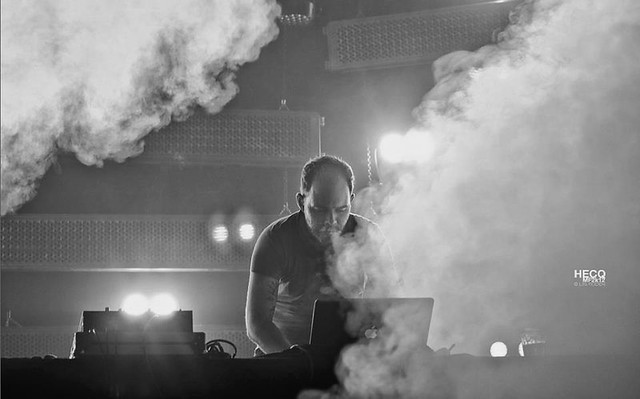Smile! You're on CCTV // The Separation of Choon and State

In 1992, Castlemorton Common Festival sparked a moral panic around illegal raves. What made it unique was both the scale (20,000-40,000 attendees over a full week, the biggest of its kind for a decade) and its visibility in the public eye. The police faced criticism from the local town for their ‘soft touch’. In fact, the police arrested over 50 people, 10 of whom were taken to court for public order offences. After pressure from the media around the growing ubiquity of illegal raves, Parliament passed the now notorious Criminal Justice and Public Order Act of 1994. This act made the unusual move to police music itself, banning parties that play, "sounds wholly or predominantly characterised by the emission of a succession of repetitive beats”. The state used this legislation to criminalise raves on the basis of the music they played. It acted as a fatal blow for UK rave, from which it never really recovered.
There were acts of musical protest that immortalised Parliament’s decision in 1994. The Prodigy’s ‘Their Law’ is a direct response to the bill, and Orbital's ‘Are We Here?’ single contains a ‘Criminal Justice Bill mix’ comprising four minutes of silence. Autechre mocked the wording of the bill with their Anti EP, written to be both rave-able and at the same time non-repetitive. The packaging of the CD wore a sticker with the following message:
“Warning. 'Lost' and 'Djarum' contain repetitive beats. We advise you not to play these tracks if the Criminal Justice Bill becomes law. 'Flutter' has been programmed in such a way that no bars contain identical beats and can therefore be played under the proposed new law. However, we advise DJs to have a lawyer and a musicologist present at all times to confirm the non repetitive nature of the music in the event of police harassment.”
There is something delicious about the idea that the contents of the CD could only be accessed by breaking the seal that the message was printed on. Finally, in The Streets’ ode to rave, ‘Weak Become Heroes’, Mike Skinner reads what sounds like a eulogy to mark the death of the good times: “Out of respect for Johnny Walker, Paul Oakenfold, Nicky Holloway, Danny Rampling and all the people who gave us these times. And to the government, I stick my middle finger up with regards to the Criminal Justice Bill.”
There are recent echoes of rave and its antagonisms with the state. One of the most renowned and egregious examples of club policing comes from the world of grime. Form 696 was a necessary license to be submitted to the London Metropolitan Police 14 days in advance of an event in any of London’s 21 boroughs. The aim of the form was to, “identify and minimise any risk of serious violent crime happening”. Billed innocuously as a ‘Promotion Event Risk Assessment Form’, Form 696 is actually an exercise in racial profiling and social control. In its original incarnation, the form required promoters to specify the ethnic demographic of attendees, as well as the names, stage names, private addresses, and phone numbers of all performers. After pressure from high profile musicians, the police removed questions requesting information relating to race, but retained the highly racialised questions of genre.
Nights listing grime, bashment, R&B, garage and so on were highly targeted, shut down by police before they could begin due to ‘safety warnings’ and even ‘terrorism scares’. The same level of scrutiny was not applied to metal, punk or hardcore nights despite their notoriously frenetic live shows. This is the continuation of racist policing by other means. The form was supposedly scrapped at the end of last year, but many promoters have since stated that other forms fulfilling the same purpose have been used.
There were two unintended consequences of Form 696 that inadvertently helped spread the popularity and influence of grime in the early years. First, the form was initially only required by London promoters. Grime thus moved outside the city and into other neighbourhoods, helping to spread the genre to new audiences. Form 696 also targeted shows which, “predominantly feature DJs or MCs performing to a recorded backing track”. In a sly attempt to sidestep the technicality of the wording, some promoters began hosting nights with instrumental grime. A new mutation of the original genre: grime without the ‘rime’.
In the last few years, grime has finally become an accepted form of mainstream music, with drill music becoming the new Met scapegoat of choice. Despite their international success, groups like 67 are subjected to heavy police interference. In an interview with Clash, Scribz explains that the police have tried to censor the band altogether, cancelling or postponing shows to make it near impossible to book tours. Scribz was even issued an ASBO banning him from making music, leading to a new mysterious masked member, ‘LD’, taking his place. In a move that mirrors MF Doom’s ‘super villain’ stage persona and the use of stand-in performers, Scribz now ‘ghostwrites’ for LD (although the distinction between the two remains ambiguous).
"...The anarchic spectre of UK rave may be back to haunt Europe once again..."
Earlier this month, the Metropolitan Police revealed that the number of illegal raves has nearly doubled, from 70 to 133, between 2016 and 2017. The Guardian reported that these unlicensed events, “ranged from a rave in Liverpool accessible only by an underground tunnel, to parties in a field in Berkshire and an industrial estate in West Sussex. Last year in Hounslow, 1,500 people descended on a closed-down Morrisons, set up sound systems and kept going until riot police stormed the venue.” The anarchic spectre of UK rave may be back to haunt Europe once again.
Why have parties moved to fringe once more? The answer might be disappointingly simple. Last year, the London Mayoral Office announced that the city has lost 50% of its nightclubs and 40% of its live music venues over the past eight years. There are varied and interlinked reasons for this. There are economic catalysts: the unmanageable growth of London’s rent and falling wages in real terms. But these also have knock-on social effects. In central London, property developers are on a continual ‘cool-hunt’, transforming cultural hubs into plush glass monstrosities: ‘luxury flats for luxury twats’. The increased presence of these properties correlates with a rise in expensive noise-abatement notices. It is probably safe to assume, with the transformation of the Heygate Estate from social housing into holiday homes for foreign investors, that the days of Corsica Studios are numbered. Because wherever the icy net of property development draws tighter, nightlife dies.
There is also the apparent unwillingness of millenials to ‘go out’. 18-34 year olds spend more of their weekends inside, and alcohol consumption amongst young people is at all-time low. People who don’t understand politics point to iPhones and narcissism as the cause. The argument goes that ‘young people’ are too self-obsessed and addicted to Netflix to live authentic, joyful lives. Rather than socialising, we would rather argue about gender politics on the Internet; we would rather binge box-sets than booze. Any young person living in London knows this is crap. The causes aren’t personal, they’re material. The spike in rent and student debt, alongside casualised employment and enfeebled trade unions mean that Millennials will be the first generation to wind up poorer than their parents. For some reason, Printwork’s eye-watering entry fees or the £5 pricetag for a bottle of beer take the charm out of an evening.
Another issue is the increased securitisation of nightclubs, with humiliating and dehumanising processes to maintain ‘safety’. Two years ago, many celebrated the reopening of Farringdon’s fabric nightclub after it was forced to shut its doors following two drug-induced deaths inside. But the conditions of reopening included increased CCTV surveillance and ‘covert surveillance’ within the club. Depending on how charitable you want to be here, the meaning of ‘covert surveillance’ could range from plain-clothed cops to G4S to just more bouncers on the dancefloor. At the heart of the capital city, fabric has always been close enough to the ugliness of modern commercial culture to be included within it. But the state won new concessions against the club: they won greater control and state regulation in exchange for the continuation of fabric’s name and legacy.
The idea of the ‘state sanctioned’ club is an oddly modern one. Afterall, the counter-cultural nature of illegal raving is part of what gave it a rebellious allure in the first place. Amidst an intense culture of ecstacy, dubplates and pirate radio, illegal raves were both an act of indulgent hedonism and calculated defiance. The very ambiguity of purpose was part of what made raves transgressive in the first place. There was no real ‘point’ to it, but it felt good. To an outside observer, the rantings and ravings of pillheads and pirate radio MCs was a tale told by an idiot, full of sound and fury, signifying nothing. But to anyone on the inside, ‘in the know’, it was everything.
Simon Reynolds wrote in Energy Flash that if raves had any purpose, it was to, “make of joy once more a crime against the state". By their very nature, raves were first and foremost criminal activity. They operated away from the proximities of power, offering a glimpse of self-determination and radical freedom. Whenever the state did try to intervene, ravers found creative and ingenious ways to circumvent it. Although seemingly ‘mindless’, raves nonetheless function as a psychological corrective, to minimise hierarchy and maximise freedom. This joy can only be found in opposition to the state, not alongside it.
Listen to our latest radio show on music and the state, with Dr. Monique Charles & Hence Therefore here.
- Published
- Mar 31, 2018
- Credits
- Words by Georgie_McVicar
